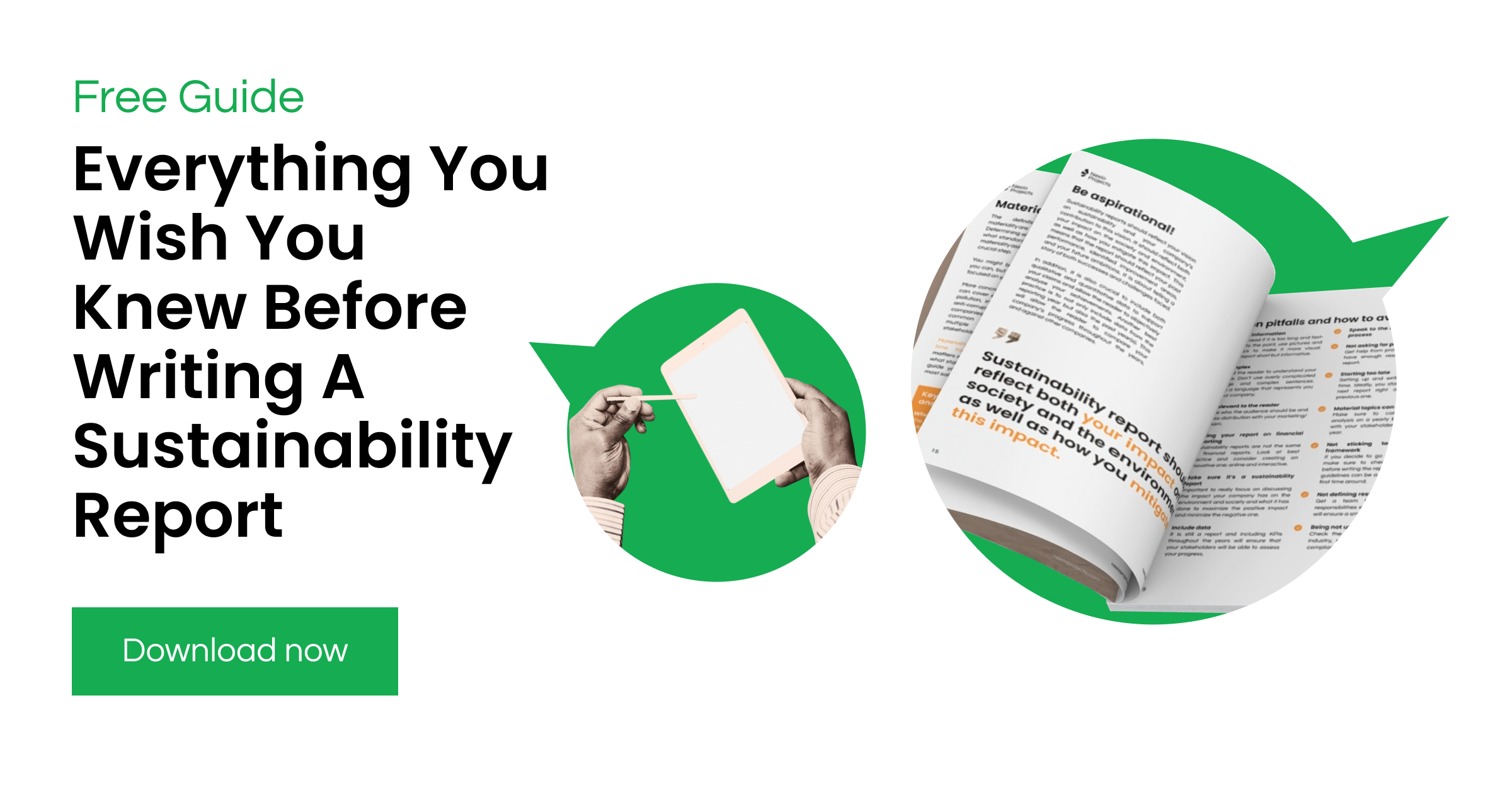Everything You Wish You Knew Before Writing A Sustainability Report

Introduction
Are you in the process of writing a sustainability report?
Are you encountering struggles along the way and wish to optimise them for next time?
Are you thinking of writing a report, but are unsure where to start?
We have created this guide to support you and your organisation throughout your sustainability disclosures.
This guide provides the following:
- A summary of key steps in the sustainability reporting process;
- Explanation of how to conduct them;
- Best practices to make the process as efficient as possible.
Start early
Writing a sustainability report can be a lengthy process and the best way to manage the different steps is to start as soon as possible. While people often only think about the drafting stage, the preparation is just as, if not more, important. To get the most out of the report, we advise completing these steps before the drafting begins.
- Set up a timeline
- Engage with stakeholders
- Conduct requirements research
- Assign and align tasks and responsibilities
- Align the C-suite
- Involve the comms team
Include materiality
Determining what is material to your organisation, what standards to follow and how to use the materiality assessment to guide reporting is a crucial step.
You might be inclined to include everything you can, but it is important to keep the report focused on the identified material topics.
Key questions that will be answered through a materiality analysis are:
- Who are my organisation's key stakeholders?
- What are the areas of material focus?
- Where should we focus our efforts and resources?
If you want to know more about materiality, please have a look at our dedicated eBook - Guiding You Through the Materiality Assessment.
Stakeholder engagement
To identify and assess material impacts, your organisation will unavoidably have to engage with relevant stakeholders before initiating the sustainability reporting process.
Examples of stakeholders are employees, boards of directors, clients, suppliers, nongovernmental organisations, local communities, and/or academics.
Opening the conversation with stakeholders can have strong benefits for your organisation:
- Identify strengths and weaknesses
- Manage risks
- Communicate with stakeholders
- Contribute to ongoing learning
Know your audience
It is important to keep in mind that sustainability reports are generally targeted at an external audience. Defining the external audience is up to each organisation, but will likely include investors, customers and partners. This is important to distinguish as different audiences will be interested in different types of content. While investors are primarily looking for links between sustainability and financial performance, consumers want to see the overall picture of your organisations’ impact on society and the environment. There are a number of frameworks to align with to ensure that reporting is relevant and accurate.
Although the main targets may be external, a CSR report constitutes an efficient tool to communicate sustainability efforts with employees. On top of raising awareness, it also contributes to increasing motivation and commitment towards achieving sustainability goals.

Choose a framework
By now, a multitude of different sustainability reporting frameworks has been developed.
Among the many, the following are the most commonly used:
- Global Reporting Initiative, GRI
- United Nations Global Compact, UNGC
- Sustainable Development Goals, SDGs
- Carbon Disclosure Project, CDP
- Integrated Reporting, IIRC
To get an overview of each of them, take a look at our guide on the main non-financial reporting frameworks.
Be aspirational
Sustainability reports should reflect your organisation’s vision of sustainability as well as its contribution to this vision. It should reflect both the impact on society and the environment, as well as how management mitigates this impact. This means that the report should reflect past performance, identified improvement areas, and future ambitions. It is about telling a story of both successes and challenges faced.
In addition, it is also crucial to include both qualitative and quantitative data to support claims and allow the reader to objectively analyse achievements. Another best practice is to include longitudinal data as far back as possible. This will allow the reader to compare your organisation’s progress throughout the years, and compare it to others.
A sustainability report should reflect both the impact on society and the environment, as well as how management mitigates this impact.
Ensure credibility
To make sure your sustainability report is perceived as credible and trustworthy by your audience, we encourage you to:
- Align with frameworks;
- Back it up with data;
- Be authentic;
- Review the report by a third party.
Communicate well
Internal communication
Employees should always be involved in the sustainability reporting process as they ultimately are the implementers of sustainability-related initiatives.
- Include employees from the start
- Get management involved
- Engage with department heads for data collection
External communication
In order to achieve success with your sustainability report and the communication around it, it’s important to have a clear goal. What are you looking to achieve with your report? Additionally, it’s important to always apply the principles of sustainability reporting:
- Which topics are material to your organisation?
- What impacts do you have on these topics?
- Which stakeholders are affected by these impacts?
- How will you manage these impacts?
Common mistakes to avoid
Information overload
Your report will not be read if it is too long and text-heavy. Get to the point, use visuals and infographics. Keep the report short but informative.
Overly complex
You want the reader to understand your message. Don’t use overly complicated language and complex sentences. Choose a language that represents you and your organisation's tone of voice.
Lacking relevance
Decide who the audience should be and discuss distribution with your marketing/PR team.
Only focusing on the financial
Sustainability reports are not the same as financial reports. Look at best practices and consider creating an innovative one; online and interactive.
Only discussing internal actions
It’s important to really focus on discussing the impact your operations have on the environment and society. The report should cover what it has done to maximise the positive impact and minimise the negative.
Lacking data
It is still a report and including KPIs throughout the years will ensure that your stakeholders will be able to assess your progress.
Forgetting about the design work
The design will be equally important as the content in making sure your report is read.
Not asking for professional help
Get help from professionals if you don’t have enough resources to write the report.
Starting too late
Setting up and writing a report takes time. Ideally, you start prepping for the next report right after finishing the previous one.
Not including materiality
Make sure to conduct materiality analysis on a yearly basis and engage with your stakeholders throughout the year.
Not sticking to the chosen framework
If you decide to go with a framework, make sure to check what it entails before writing the report. Adhering to the guidelines can be a lengthy process the first time around.
Not defining responsibilities
Get a team together and assign responsibilities early in the process. This will ensure a smooth process.
Not being up-to-date
Check the latest legislations for your industry, market, or country to ensure compliance.
Best-in-class examples
Finally, download the complete Guide to Sustainability Reporting to access a selection of best-in-class examples for sustainability reporting.
We've selected eight organisations which we believe set best practice when it comes to disclosing their sustainability efforts.

